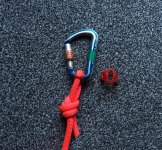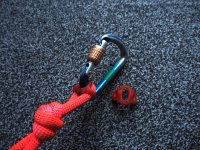Can we start with the number of people that have ever been injured by the impact of falling on to cowstails in a cave?
I don’t know anybody who has been injured falling onto cows tails.
I wouldn’t be all that surprised if nobody ever has been injured.
I would be surprised if nobody has ever had a greater than FF1 fall onto them because, although people on this forum know that certain things shouldn’t be done underground, when people are tired, in a rush etc. those things are sometimes done. The various CROs get much of their custom from people making silly mistakes. And the FF theory is quite difficult compared with the idea that you should put a knot in the end of your rope, or that you shouldn’t ab a pitch without the ability to get back up.
The peak force on an average weight caver suffering a clean FF2 fall onto a typical knotted long cows tail will be around 5kN. The solid steel caver gets about 7kN.
Unless you are unlucky 5kN is survivable without serious injury, though perhaps not pleasant.
Taking out the knots and substituting sewn loops will push that up a lot.
I can’t imagine why people would want to risk that for the sake of being able to adjust the length, when a knot at the bottom and something like a Kong Slyde at the top will do the job just as well and retain the energy absorbing capacity.
Individuals are free to do as they like in this respect, but I do hope that sewn rope lanyards are never formally recommended as suitable for use as cows tails.
That Lyon Equipment report from 2001 that Bob referenced above is a long read, but on P81 it says:
"The tests show that the best material for cow’s tails is knotted dynamic rope. Of the knots tested, the Barrel knot produced the lowest impact forces, followed by the figure-of-eight.
As well as having the benefits of easy adaptation to the user it is currently the only way in which acceptable impact forces can be achieved.
…………………………………………………………………………………………………………………….
There are sewn termination rope cow’s tails on the market made from both dynamic and static rope: while these may be applicable to low fall factor situations, neither are suitable for use as cow’s tails.
Sewn dynamic rope cow’s tails should be restricted to uses where the maximum possible fall is fall factor 1".



